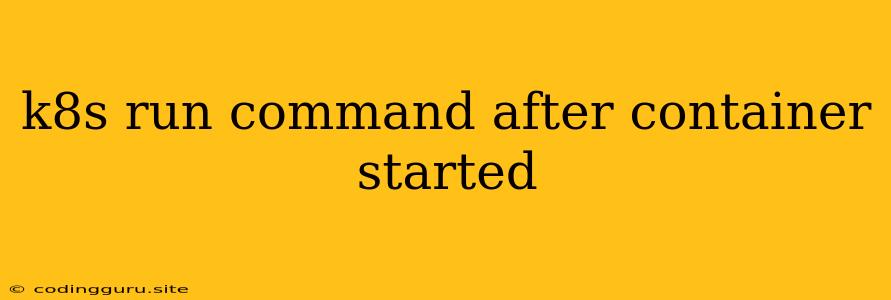Running Commands After Container Startup in Kubernetes
Kubernetes, also known as k8s, is a powerful container orchestration platform that simplifies managing and scaling containerized applications. While containers offer a self-contained environment for applications, often, you might need to execute commands within a container after it's successfully started. This could be for tasks like configuring the application, running data migrations, or performing maintenance operations.
The Challenge
Kubernetes doesn't offer a direct mechanism to run a command instantly after a container starts. The standard approach using kubectl exec requires you to manually initiate the command, which isn't ideal when you need a command to run automatically after container initialization.
Solutions
Let's explore different techniques to address this common challenge:
-
Using Init Containers:
- Concept: Init containers are a powerful feature in Kubernetes that allows you to execute commands before the main container starts. These containers are designed for tasks like setting up the application environment, fetching dependencies, or preparing data.
- Implementation: Define an init container in your deployment or pod specification. This container will run its specified command before the primary container starts.
- Example:
apiVersion: apps/v1 kind: Deployment metadata: name: my-app spec: replicas: 3 selector: matchLabels: app: my-app template: metadata: labels: app: my-app spec: initContainers: - name: setup-script image: busybox command: ['sh', '-c', 'echo "Setting up the environment" && sleep 10'] containers: - name: my-app image: my-app-image:latest command: ['/bin/bash', '-c', 'echo "Main container started"'] - Advantages: Provides a clean and structured way to handle tasks that need to be executed before the primary container.
- Disadvantages: Each init container adds additional resources and complexity to your deployment.
-
Leveraging Entrypoint and Command:
- Concept: The
entrypointandcommandfields in the container definition allow you to specify the command to be executed when the container starts. By chaining commands, you can run the initial setup followed by your application. - Implementation: Set the
entrypointto a script that performs your initial tasks and then starts your main application command. - Example:
apiVersion: v1 kind: Pod metadata: name: my-app-pod spec: containers: - name: my-app image: my-app-image:latest entrypoint: ["/bin/sh", "-c", "echo 'Initial setup' && sleep 5 && /usr/bin/myapp"] - Advantages: Simplifies container setup by combining initialization with the application start command.
- Disadvantages: Can lead to more complex and less maintainable container configurations.
- Concept: The
-
Post-Start Hook:
- Concept: A post-start hook allows you to define a script or command that will be executed when the container is ready after starting.
- Implementation: Add a
postStartlifecycle hook to the container definition within your deployment or pod specification. - Example:
apiVersion: apps/v1 kind: Deployment metadata: name: my-app spec: replicas: 3 selector: matchLabels: app: my-app template: metadata: labels: app: my-app spec: containers: - name: my-app image: my-app-image:latest lifecycle: postStart: exec: command: ['sh', '-c', 'echo "Post-start script running"'] - Advantages: Provides a dedicated way to execute commands after container startup, independent of the application's main command.
- Disadvantages: Requires careful consideration of the timing and potential resource conflicts with the main container.
-
Using a Sidecar Container:
- Concept: A sidecar container runs alongside the main container within the same pod. This container can execute specific tasks, such as monitoring, logging, or data processing, independently of the primary application.
- Implementation: Define a sidecar container in your deployment or pod specification. The sidecar can contain scripts or services that can be initiated using
kubectl exec. - Example:
apiVersion: v1 kind: Pod metadata: name: my-app-pod spec: containers: - name: my-app image: my-app-image:latest - name: sidecar image: sidecar-image:latest command: ['sh', '-c', 'echo "Sidecar container running" && sleep 10'] - Advantages: Offers modularity and allows you to separate the initialization logic from the primary application.
- Disadvantages: Adds more resources and complexity to your deployment.
-
Kubernetes Job or CronJob:
- Concept: For time-based or one-off tasks, Kubernetes Jobs or CronJobs provide a way to schedule commands to run within a container at specified intervals.
- Implementation: Define a Job or CronJob that targets the container you want to run the command in.
- Example:
apiVersion: batch/v1 kind: Job metadata: name: my-job spec: template: spec: containers: - name: my-job-container image: my-app-image:latest command: ['sh', '-c', 'echo "Job running" && sleep 10'] - Advantages: Provides a dedicated mechanism for scheduled tasks, independent of the container's lifecycle.
- Disadvantages: May require careful configuration to ensure the Job or CronJob runs at the desired time.
Conclusion
Choosing the right method to execute commands after a container starts in Kubernetes depends on your specific requirements. Consider factors like the nature of the command, its frequency, and its impact on the main application. By understanding the available techniques, you can seamlessly integrate post-startup commands into your Kubernetes deployments and ensure smooth application operation.
